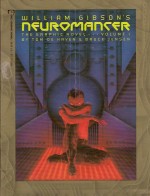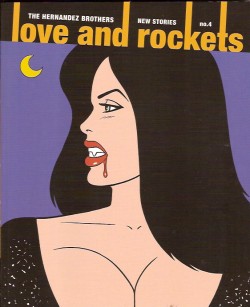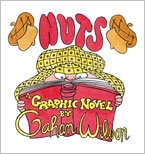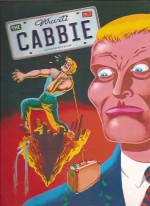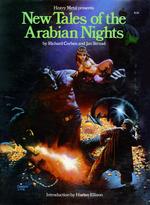
By Richard Corben & Jan Strnad (Heavy Metal Books/Simon & Schuster)
ISBN: 930-36844-4
Richard Corben is one of America’s greatest proponents of graphic narrative: an animator, illustrator, publisher and cartoonist, springing from the tumultuous wave of independent counterculture commix of the 1960s and 1970s to become a major force in comic storytelling with his own unmistakable style and vision. He is equally renowned for his mastery of airbrush, captivatingly excessive anatomical stylisation and delightfully wicked, darkly comedic horror, fantasy and science fiction tales.
Until relatively recently Corben steered clear of the Fights ‘n’ Tights comicbook mainstream. He didn’t sell out – American publishing simply caught up, finally growing mature enough to accommodate him, due in no small part to his broad and pervasive influence…
Born in Anderson, Missouri in 1940, he graduated with a Fine Arts degree in 1965 and found work as an animator. At that time, the neutered comicbooks of the Comics-Code Authority era were just starting to lose disaffected, malcontent older fans to the hippy-trippy, freewheeling, anything-goes publications of independent-minded creators across the continent who were increasingly making the kind of material Preachers and Mummy and her lawyers wouldn’t approve of…
Creativity honed by the resplendent and explicitly mature 1950s EC Comics, Carl Barks’ perfectly crafted Duck tales and other classy early strips, a plethora of young artists like Corben responded with a variety of small-press publications – including Grim Wit, Slow Death, Skull, Fever Dreams and his own Fantagor – which featured shocking, rebellious, sexed-up, raw, brutal, psychedelically-inspired cartoons and strips blending the new wave of artists’ unconventional lifestyles with their earliest childhood influences… honestly crafting the kind of stories they would like to read.
Corben inevitably graduated to more professional – and paying – venues. As his style and skills developed he worked for Warren Publishing in Eerie, Creepy, Vampirella, Comix International and outrageous adult science fiction anthology 1984/1994. He famously coloured some strips for the revival of Will Eisner’s the Spirit.
Soon after he was producing stunning graphic escapades for a number of companies, making animated movies, painting film posters and producing record covers such as the multi-million-selling Meatloaf album Bat Out of Hell. He never stopped creating comics but preferred personal independent projects with collaborators such as Bruce Jones, Jan Strnad and Harlan Ellison – who provided an effusive introduction here.
In 1975 Corben approached French fantasy phenomenon M̩tal Hurlant and became a fixture of its American iteration Heavy Metal Рfrom which this stunning saga was collected.
Always garnering huge support and acclaim in Europe, he was regularly collected in luxurious albums even as he fell out of favour – and print – in his own country. This particular tome gathers a particularly impressive fantasy serial from the early days of Heavy Metal (specifically from June 1978 to August 1979) which cunningly reveals the final voyage and fate of a legendary hero…
This superb, criminally out-of-print but still readily available fable opens with a history of the charismatic storyteller Shahrazad and how she charmed her murderously strict husband, then goes on to concentrate on the tale she kept from him; and only shared with her wayward sister Dunyazad… ‘Sinbad in the Land of the Jinn’.
‘The Last Voyage of Sinbad’ begins when merchant Badr al-Bakkar recognises a Sufi sage as the legendary seaman and begs to know what turned such a worldly warrior into a penitent priest. As the broken old wanderer speaks of his secret Eighth Voyage a saga of tragedy and wonder unfolds…
Sinbad was a bored and restless husband who broke many of the Prophet’s Holy Injunctions and, whilst drunk one night, encountered a Jinn who attacked him, claiming the sot had killed his wife.
In retaliation the supernatural horror demanded the life of Sinbad’s beloved spouse Zulaykha, but could not find her…
The woman had vanished from the face of the Earth and the terrified adventurer resolved to find her and save her from the vengeance of the merciless Ifrit.
He is aided in his quest by the enigmatic Akissa, who claims to be the selfsame demon wife Sinbad supposedly murdered. She wishes to be divorced from her brutal trickster husband and offers to guide Sinbad and his crew to the magical realm of Zu’l Janahayn, the Jinni King of Kings who can grant any wish should he please. All they must do is find his floating citadel of Ketra…
And thus begins a quest of shocking terror, stupendous action, wanton debauchery and stunning duplicity, which resulted in the near-breaking of our hero, magical horrors and valiant perseverance…
The artist’s infamous signature-stylisation includes abundant nudity, excessive, balletic violence and astoundingly proportioned male and female physiques and these are all prominently displayed in this cunning and beguiling continuation of the fabulous legend of an immortal hero, which still finds room for a brilliantly contemporary twist…
Richard Corben is a unique visual stylist blessed with a love of the dark and graced with a scathingly sharp sense of humour. Combine that with our apparently insatiable hunger for monsters and mystery and this book becomes the ideal treat to while away the witching hour…
© 1978, 1979 Richard Corben and Jan Strnad. Introduction © 1979 Harlan Ellison. All rights reserved.

